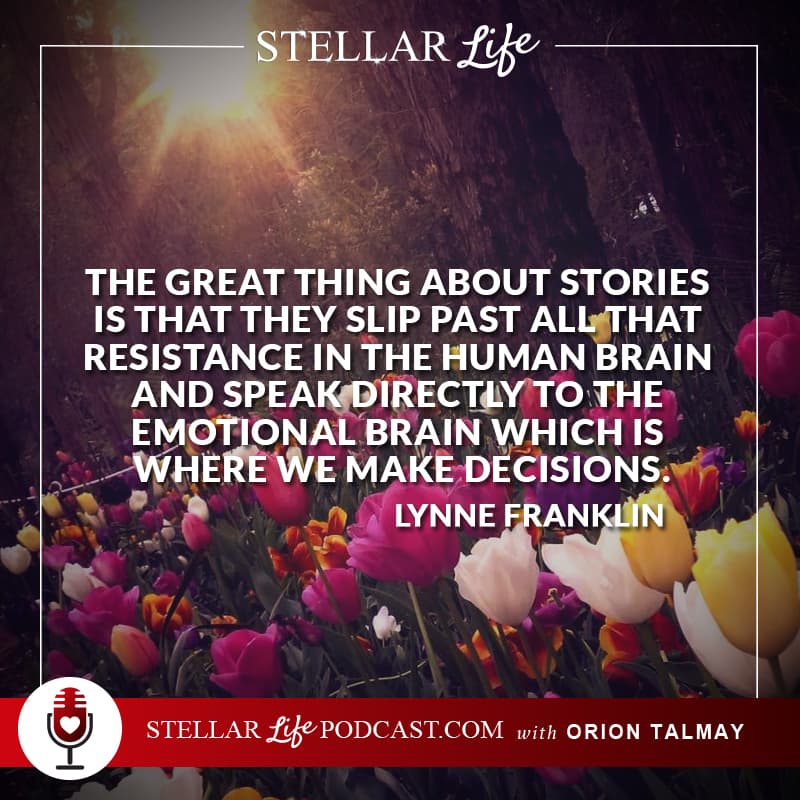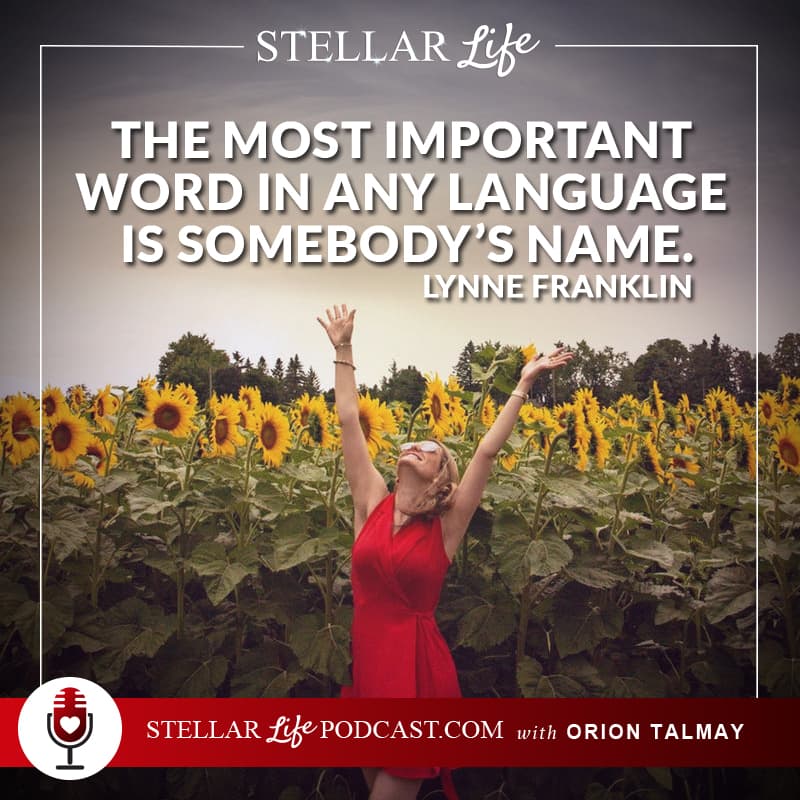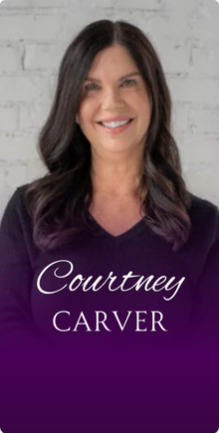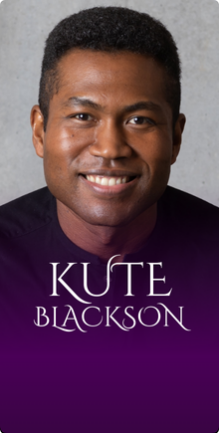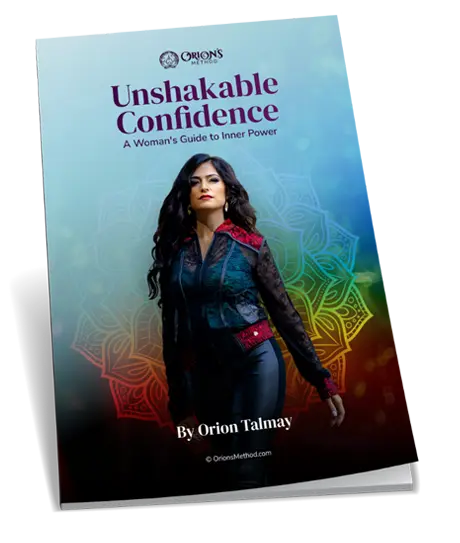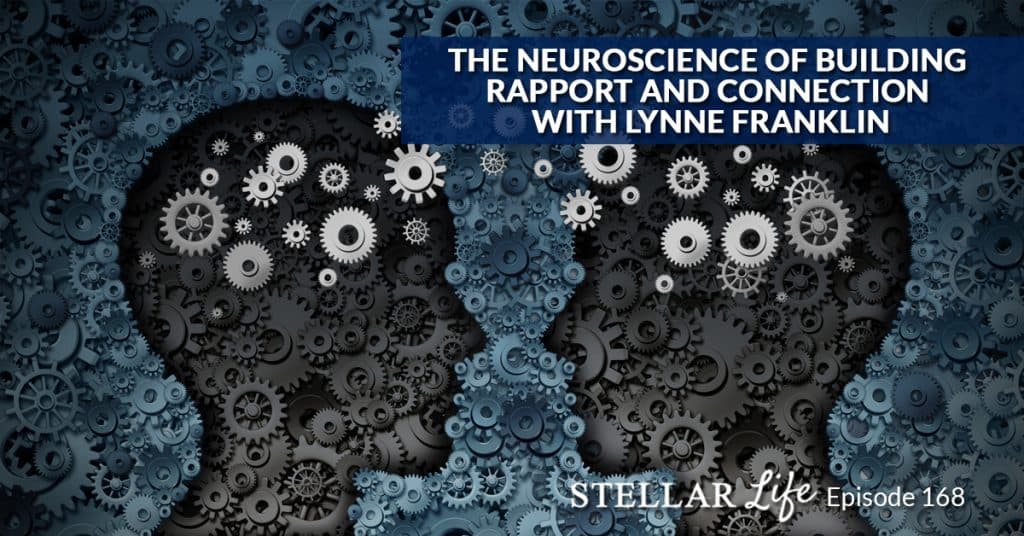
About Today’s Show
Hey, Lynne. Welcome to Stellar Life podcast.
It’s a pleasure to be here.
Before we start, why don’t you share a little bit about yourself and what you do?
What I am is a neuroscience nerd which means I study how the brain works, and then, I take arcane research and turn it into easy-to-use tactics and strategies to help people build rapport and connection faster.
What started this fascination with neuroscience and influence?
It started really when I had my first job out of college. I was a residential treatment counselor in a home for troubled boys. The toughest day I ever had a job, I had there. I worked with 11-17-year-old boys who for one reason or another, couldn’t live at home. One day, when I was in Daniel Cottage where I worked, a boy named Fred who had run away two days ago came back. Fred was young and 14 years old. In that moment, I could have told you anything about Fred despite the fact he was standing three feet away from me because all I could see was that he was holding the world’s largest machete and he said, “You try to call for help, I’m going to cut you.”
When you listen to understand rather than respond, you make others feel seen truly and heard. Share on XFred had shown up about five minutes before and because I was young and inexperienced and the only adult there, I thought it was my job to tell Fred what to do. When he arrived, I said, “Fred, you can’t be here. You have to go to intake. You have to tell them what you have been up to for the last couple of days so they can clear you to be here.” Fred said, “No, I’m going to my room.” I said, “Fred, why are we having this conversation? Just go to intake.” “No, I’m going to my room.” “We can do this the easy way or the hard way. Just go to intake.” “No, I’m going to my room.”
I went to the staff office to call for backup so I could have somebody be with the other boys while I work with Fred to get him to intake. That’s when he followed me in the office, zipped open his backpack, and whipped out that huge machete. I was standing there with the phone in my hand and at that moment he brought down the knife on the phone cord and cut it which meant I had just lost my connection to the outside world. I also lost my mind. There were boys in the hallway behind Fred fizzing with energy because Fred might knife me. There was even one kid who said, “Fred, my man. Going to cut a staff to the bone.”
At the moment, all I could think of doing was babble. I’m standing there saying, “Fred, Fred. I like you and you like me. You don’t want to hurt me.” There was nothing in how Fred’s looking at me that’s saying he’s agreeing with any of this stuff, so I just keep babbling. I say, “You don’t want to get into the world of hurt you’re going to get into if you hurt me.” At that moment, I saw Fred blink.
Later, he told me that he started thinking about what his life would be like if he actually knifed me and that Daniel Cottage wouldn’t be his home, the boys in the hallway wouldn’t be his friends, I wouldn’t be there to help him, the police would come and they would take him off to juvenile hall and they would lock him up. But all I saw was the blink and somehow, I knew it was my chance. I stuck my hand out and said, “Fred, just make it easy on yourself and hand me the knife.” I was scared to death that he’d bring that knife down and chop my hand. But I also knew that I had to keep it out there. I had to let Fred know that I thought he was a good kid and give him the chance to act like one.
I can’t tell you how long I stood there, sweating through everything I had on until Fred finally gave me the knife. I remember taking it from him and turning around and putting it in this locked closet right behind me and then just leaning my head against the cool wood on the closet and taking a deep breath. And then turning around and looking at the boys in the hallway and saying, “Okay, the show’s over. Find something to do or I’ll find something for you.” And there is nothing like telling teenage boys that you will find something for them to do that makes them, “No way!”
Then, I turned around and looked at Fred and there he was -this skinny kid in dirty cutoff jeans, a dirty red t-shirt that just hung on him, giant scuffed up tennis shoes, and hair plastered to the side of his head. I said to him, “Fred, sit down before you fall down.” I knew his story. I knew that his mother was a schizophrenic and she was a single mother. He said to me, “I went home to be with my mom. Everytime I’m in the house, she says, “Go outside. Get out of here. Get your butt outside and play.” I go outside and play, and she’d say, “Get your butt back inside. There is nothing I can do to please this woman.” I thought yes and there I was saying, “Go to intake.” I was just another adult looking through him and not paying any attention to him. He had to pull a knife in order to get my attention.
If this scenario happened today, what would you have done differently?
What I would have done differently is I would have seen Fred instead of seeing the rules. I would have asked him to come in, sit down, talk to me, and listen to him first before telling him what to do. I would also have known that when you’re in crisis—and in this instance, both of us because we were in crisis in a different way—that you literally lose two-thirds of your brain and all you have left is fight, flight or freeze.
Fred was in the fight and I was in the freeze. And then, I would have been able to say to Fred to move him out of fight. I would have been able to say, “Fred, tell me what you’re feeling.” Because that’s the problem and that begins by getting back the two-thirds of the brain that are gone. Frankly, I have to laugh, because this was what set me on the journey to figuring out how you reach unreachable people. It’s also become the litmus test for my job which is as long as nobody pulls a machete on me, I’m having a good day.

That’s a good way to live. Very low standards. But it’s wonderful because I know for myself, sometimes I look for validation and appreciation, to be loved and to be cared for. When I don’t get it from people, I’m like, “Ugh.” That’s like my machete. It’s not as big, it’s not as dramatic, but how do you switch this off? Caring about what other people think so much?
With Fred, he truly was somebody who was looking for love. Frankly, when the unit supervisor showed up because they kept calling the cottage and there was no answer because the phone cord was cut, he came down and I sent Fred back to his room and explain to Tom, my supervisor, what had gone on and he said, “We have to bounce him. We can’t have kids in this program who bring weapons in.” I said, “But he’s a good kid. He trusted me. He gave me the knife. He didn’t harm anybody. We have to give him a chance.” And because Fred was a good kid and because the unit supervisor, Tom and I, cared about him, we were able to keep him in the program. He graduated and didn’t end up on the street, in jail, or dead. It’s knowing when somebody needs that kind of support and just giving them that lifeline that gave Fred the chance and frankly, made me understand just how powerful it is to actually see other people instead of seeing what I think I’m supposed to.
I get it. But what happens when you feel unseen by others?
I think that most of us wander around truly feeling unseen and unheard everyday. A lot of times, we don’t make a difference or connect with anybody which is one of the reasons why it’s a blessing whenever I get the chance to be with somebody just to sit, ask a couple of questions and listen. Because there are two ways to listen.
One way and it’s the most common is people listen to respond. I listen to what you’re saying and while you’re speaking, I’m thinking, “Well, how am I going to answer that? What’s the next thing I’m going to say?” which means we’re only paying half attention. The other way to listen, which is much more powerful, is to listen to understand, to pay attention to what somebody is saying and to truly know what’s going on with them. Then, make our comments and our replies based on what they’re saying and use paraphrasing and other things to show them that, “Yes, indeed. We do care enough for them and what they’re saying.” To really understand rather than just respond. When somebody listens to you to understand rather than respond, you do truly feel seen and heard.
But what happens when they don’t?
You’re absolutely right. Some of that we need to carry along in ourselves. We need to pay enough attention to ourselves that when other people don’t or can’t, it doesn’t destroy us.
People can only listen for seven minutes without taking a brain vacation or getting distracted. Share on XHave you ever felt unseen?
Certainly. It’s funny because you ask how I got to where I am, in a sense. It was about eight years ago, I decided I wanted to be a better version of myself. I started looking around for personal development programs. A lot of them I discover—at least at that time—had this kind of happy talk approach of, “Think good thoughts and good things will happen to you.” I’m a true believer in the power of positive thinking and setting intentions but, at the same time, sitting in my office and thinking good thoughts is not going to make my phone ring and get me my next speaking opportunity.
One program I came across was based on neuroscience and I thought, “Okay. Once I understand how the brain works and how people think and how they feel, then I can use what I’ve learned to make myself stronger and create a better life for myself.” That became the journey for me on neuroscience. Why do things happen as they do? What can I do, knowing how my brain and the brains of other people work, to make things happen faster? Like building rapport and connection.
What are some of the first steps to building rapport?
My personal favorite because everybody goes to events where they don’t know people. Tell me if this has ever happened to you. You start talking to somebody, you introduce yourself, they introduce themselves, and about two minutes later you realize you cannot, for the life of you, remember the name of that person. Has that ever happened to you?
I go to so many conferences and so many network events and I see thousands of people. My husband has a talent, he remembers names from five years ago. He refers to, “You remember when we met so and so…” and then he reminds me of this person, he describes to me this person, he remembers what they wore and I’m like, “Nope. No recollection.”
Bless him for having that capacity but most of us don’t. Here’s one of the reasons why we forget people’s names. The first seven seconds when you meet a new person, your brain is flooded with information. You’re looking at the first thing – research shows we look at is people’s hair. We’re looking at their hair, their eyes, what clothes they’re wearing and how they sound. Our brains are just on overload. On top of that, research shows that people’s names have no inherent meaning in our brains unless we already know somebody who has that name.
For example, if I were to say that my name was Norma and you’ve never met a Norma before in your life, your brain has got no place to put that. Since it’s overloaded with all this other stuff, so we forget. As opposed to, if I said my name was Red, you already have an association with Red and you can take a look at my hair and say, “Your hair is kind of reddish. I’ll remember that about you.” What ends up happening is that in order to bypass this problem which is how your brain works, whenever you’re in a networking opportunity or meeting one or more new people, never introduce yourself or ask of that person’s name within the first seven seconds. You know your brain is on overload. Instead, ask a simple question like, “Is this your first time at this conference?” Or make a comment about the weather and let them respond. By that point, seven seconds have probably gone by which means your brain is starting to settle down. It’s at that moment you can ask that person’s name and introduce yourself and obviously, look them in the eyes and say their name a couple of times in short order. So, “Orion, it’s a pleasure to meet you. How far did you get here to travel, Orion?” Say that a couple of times and then…
You will remember.

Right. I’ve moved your name from my short-term memory into my long-term memory because research also shows that the most important word in any language is somebody’s name. We have to pay attention and focus on that person’s name.
What happens when you’re in a circle. You know, those circles, where it becomes like a symphony of handshakes. Like, “Hey, I’m this. I’m this. I’m this.” And then all of a sudden, you’re introduced to seven new names, seven new people. What do you do then?
For me, I do my best to look them in the eyes and say their name slowly. Also, pay attention to where they are standing around in that circle. If I meet Angie first, I’ll remember it’s Angie first and then Brian next, and I try to put it in that kind of order for myself. To say people’s names as much as I can and look them in the eyes as we’re in a conversation. Sometimes it works, sometimes we aren’t as focused as we wish we were. I say if you cannot remember somebody’s name, just pass up. I mean, it’s a situation we’ve all been in and ask. That then gives you the opportunity to focus on them again and say their name a couple of times. Does that make sense?
It makes sense. So, the first step to building rapport is remembering someone’s name and you do it by either repeating their names slowly or I guess, remembering where they are in the circle or finding some kind of an association that has something to do with their names so that you’ll remember it. What’s the second step to building rapport?
Since we’re talking about networking, it’s asking the other person to speak first. Listening to understand as they do. Because two wonderful things happen when you listen rather than speak first. The first thing is that you learn about them. If you happen to be—in this instance—a coach, a personal development coach, I’m going to respond to you differently than I will to an engineer. You’re telling me things that are important so when it is my turn to speak, I’ve understood what you’ve said and I couched whatever it is I need to say in a way that’s of interest to you.
The second wonderful thing that happens when you listen first is that it’s something called the rule of reciprocity. Because most people will notice if they’ve been speaking for five minutes, “Geez, I’ve been speaking a long time. I don’t want to be the person who hogs the conversation. It’s time for me to ask Orion a question.” I turn to you and say, “Orion, tell me more about you.” And in that moment, because you have said nothing to me and you’ve listened well, you have built goodwill with me. I want to respond and actually listen to what you have to say because you’ve made me feel good.
Those two wonderful things happen. I can tailor my comments to be meaningful to the person I’m speaking with. When it’s time for me to speak, I’ve already built goodwill, so people want to hear what I have to say.
What about mirroring and matching their body language?
That’s a wonderful thing too. In our brains, we have something called mirror neurons as in, “ mirror, mirror on the wall.” What happens is that this is very old in us as human beings because back in the old days, when we were in the jungle, we were part of tribe and the idea was you want to mirror the body language of the people in your tribe closely enough so that they don’t decide you’re too different and they’d kick you out. There’s a part of our brain that is looking at the people around us and inviting us to mirror their body language. To stand as they are standing or to sit as they are sitting, to lean in and/or lean out depending upon what they’re doing.
The great thing about stories is that they slip past all that resistance in the human brain and speak directly to the emotional brain which is where we make decisions. Share on XAll these happens subconsciously because I’m sure you’ve had the experience too – of sitting in a room and you notice that somebody is leaning in and they have their arms crossed and you noticed you’re doing the same thing. It’s all been going on in your brain without you paying conscious attention to it because here’s the wonderful statistics, your conscious mind can process anywhere from 10-40 bits of information per second. But your subconscious mind, depending upon the research you see, it processes anywhere from 14-40 million bits of information per second, so your subconscious mind is collecting all of this stuff that you’re not even aware of.
Mirror neurons are a part of that. There’s this information that’s coming into your brain but you’re not paying attention to unless you choose to, unless you choose to decide, “I’m going to pay attention to people’s body language.” One of the blessings of this too is that the people that you’re speaking with also have mirror neurons. If you’re in a situation where somebody appears to be really closed off, with their arms tightly crossed and frowning, one of the things you can do is you can take their body language and relax it one level.
Your arms are not as tightly crossed, you’re not frowning. And their mirror neurons will pick up on you and a lot of times, their body language will relax, it invites them to be more open to whatever it is that’s going on between the two of you.
I also learned that the person with the dominant presence, dominant body language and most dominant intention will affect the other people around them.
Right. Particularly when we’re not paying attention to body language but when we are, if we’re feeling frightened or less than in the moment, we pay attention to our body language and we can then hold our arm.
What do you think about Amy Cuddy’s research about power poses and body language?
I believe it. The idea is to do what makes your body feel good, to ground yourself in how you stand and how you sit because there is an energy in that. For example, most of the time, when I’m speaking with clients, I’m wandering around because I feel better and I feel more energy when I stand than when I sit. It also helps me be more present. Obviously, there’s some neuroscience behind what she shares, and I agree.
I know she got some heat because for every research that you do, you can do a research that can say the opposite. But I do believe in power poses not because I’m a scientist or I made my own personal research. I did an experiment where I was in a room with 10 more people and I adopted a powerful body language and slowly but surely you see one-by-one they changed their body language. I was actually noticing them. It was just a fun game that I did with myself. Sometimes when I’m on stage and I’m speaking, I will have people take on power poses because I do believe in that. You do see a shift in people. It’s like Tony Robbins says, “It’s the one-millimeter shift between being happy and depressed where your chin is down or up.” It makes a whole lot of difference. Your body language influences your emotions and vice versa. What influence you more? Do your emotions influence? Body language? Does your body language influence your emotions?
You know, fortunately for us, it goes both ways. I think it starts with emotions influencing body language because emotions, a lot of times, we’re not paying attention to them. They happen in our subconscious and then our body picks up on that. There are times when you’re feeling frightened, for one reason or another, and you’re more likely to have your body language reveal that fear before you’re conscious of it. I think it probably starts with feelings first, but at the same time—it’s as you said—you can adopt that power pose and then change your feelings so they’re in sync with that. I think the graphic is when you’re in somebody’s presence, if you were to do a pie chart of how you influence people, 7% of the influence you have in an in-person situation comes from your words, 33% of your influence comes from your voice, tone and quality, and 55% comes from your body language. You’re absolutely right about adopting a power pose and people respond to that much more quickly than they would respond to your voice, tone, and quality or your words.
It’s all about non-verbal communication. It’s more than what we say; it’s how we say it. You meet someone, you learn their name, you listen to them, you mirror and master body language consciously or unconsciously, what’s next if you want to see somebody who’s for example, a potential client? What are some things you can do to influence their decision to work with you or even have an initial conversation with you after a very short conversation with them?
The most important word in any language is somebody’s name. Share on XThere are really two things I think that are useful here because we’re talking about letting them speak first. When I’m with somebody, I also know the neuroscience about how you can read people’s body language to read their minds. In this instance, what happens is that I can pay attention to how you stand and the words that you use and determine how your brain thinks. And then, present my information in a way you’re more likely to see, hear, and feel it.
Let me give you some tips on this, 75% of people in the world are what’s called lookers which means their brains think in pictures and images. In order to identify those folks, I look for this kind of body language. First, they stand up straight because good posture is important to them. They usually have thin lips. They’re well-dressed. They usually have a little tension in their shoulders; their shoulders can be hunched a bit or raised up. They also have a tendency to have wrinkles in their foreheads because people look up when they are remembering what they have seen which causes the wrinkles. Also, lookers have a tendency to give you lots of eye contact.
If I want to build rapport with this people—in 75% of the people in the world—I do two things. The first thing I do is I give them lots of eye contact back because lookers truly believe that if you’re not looking at them, you are ignoring them. The second thing I do is I use visual language when I’m speaking with them, “Let’s take a look at this.” Or, “How would you envision working together in this way?” I use visual language because that’s the language that’s going on inside their brain. That’s why a quick connection with lookers who are 75% of the people of the world who think in pictures and images.
The second group of people—20% of the people in the world—are listeners. They think in words and sounds. Their body language is different from lookers because they have a tendency to not be well-dressed because appearance isn’t as important to them. They also generally look down and to the left because that’s where you look when you’re remembering something you have heard. By the way, when listeners are doing that—looking down into the left—their ear is pointed at you. Listeners use their ear the way lookers use their eyes. Other things you might notice about listeners is that they have a tendency, when they’re thinking, they either move their lips or mumble and this is because they are literally speaking to themselves. That’s how they process information.
Listeners, a lot of times, are the people who click their pens or bang on the table. It’s noise for them. If you want to create connection with listeners, you do two things. The first is you do not give them lots of eye contact because it freaks them out. If you’re dealing with a listener and they’re speaking, you look at them and you look away; if you’re speaking, you look at them and look away. The second thing you do with a listener is you use auditory words, “That sounds good to me.” Or, “I want to hear what you think about this.”
And then finally, the last group of people, 5% of the people in the world, are called touchers. These are people whose brains work kinesthetically. They think in feelings and tactilely. To know who these people are, they’re usually dressed for comfort rather than style. They generally have full lips and deep voices. They have a tendency to look down because that’s where we look at when we’re remembering something we felt. They’re called touchers for a reason. These are the people who will likely hug you whether or not they’ve ever met you before in their lives and they have a tendency to lean in, not because they want to invade your space, but because they want to decrease the amount of space between you and them. That is how they build rapport.
If you want to create connection and rapport with touchers, if you feel comfortable, let them touch you on your arm or your shoulder. But if you don’t because some of us those if we’re confronted with somebody we’ve never met before, who is coming at us to give us a giant bear hug, then stick your hand out and let them shake your hand; give them a point of contact. That’s what they’re interested in. and then you use the kind of language that appeals to their brains, “Let’s get in touch about this.” Or, “Reach out and contact me about it.” Or, “How are you feeling about this?” It’s that kind of language once again that they’re using in their brains and you use it. You’re speaking the language they speak to themselves.
How specific are those segments? It seems like you’ll find hybrids of people who are maybe touchers and lookers.
Indefinitely because your brain processes information in all three ways. But just the way you have a dominant hand for writing, you have a dominant style for your brain working. What you do is you look for the biggest cues. The easiest thing to do is to ask somebody to remember something and then watch where their eyes go. If they’re looking up, they’re lookers. If they’re looking down to the left, they’re listeners. If they’re just looking down, they’re usually touchers. That’s the easiest thing to do.
Here’s the tough thing is that once you figure out—and I do an exercise with people so they can figure out who they are—I actually ask them to close their eyes and remember and important event in their life. Take themselves back there and start paying attention to how they are remembering it. If they’re seeing it as a series of pictures or images or as a movie, they’re lookers, 75% of the people in the world. If they’re remembering what people said or describing the event to themselves then they’re listeners. If they’re remembering how things felt, or how things felt to them, then they’re touchers. That’s the good news, to figure out who you are. The bad news is that you will automatically treat as though they’re the same as you are.

For example, for me, I had a client years ago before I knew any of this stuff, and he was a corporate controller at a company. He would sit across at the conference table from me and he was always looking down with occasional glance up at me. At first, I thought, “Well, he’s a numbers guy. He’s looking down at the numbers. They gave him comfort.” The more often we’d met, the more often I thought, “Well, he’s just socially inept. He doesn’t know how to give me eye contact.” Finally, because I was young and stupid, I thought every time he looks up, he’s looking at my chest. I’m offended. There was one meeting where I actually bent down and said, “Excuse me. I’m up here.” And raised my head up like, “Ouch.” I was lucky I didn’t get fired because the scoop is, he was a listener. He was never going to give me eye contact. I needed to not change who I am but use those mirror neurons and adjust my style so that he was more comfortable.
That’s a wonderful observation. I’m sure everybody is making those mistakes because we all think that people are similar to us, they think the way we are, they act the way we are. This is a great tool to help with communication. How do you do this from the stage when it’s not one-on-one but one-to-many?
I know that 75% of my audience are lookers. I’ve used a lot of visual words to keep those people with me. The second thing is, of course, I’ve got 20% are listeners and 5% are touchers, so making sure that I share that kind of language as well. Neuroscience, because you mentioned speaking, here’s something that’s really useful and I bake it into all of my speaking programs too. It is to know that people can only listen to a talking head for seven minutes without taking a brain vacation or pulling out their phones and getting distracted. The jargon for this is every seven minutes, if not more often, you have to incorporate something called a state change. Meaning you need to change the energy in the room. You can do this in a number of different ways. I’m sure you do this all the time too, Orion. You can ask people a question or ask them to raise their hand in response to something or talk to each other or applaud or give them an exercise or even ask them to imagine something. Do something that changes their energy and keeps them in the room.
Any other tips for influencing from the stage?
Paying attention to two things in your body language. First is, and you’re going to laugh, what are you doing with your chin? A lot of speakers have a tendency to raise their chin up. We’ve heard the old quote, “Keep your chin up,” which is fine for motivating ourselves when we’re feeling down; not so great from the stage. Because every time you see somebody who has raised her chin, it appears that she’s looking down her nose at you. It could give people a sense that you’re looking superior. Pay attention to where you put your chin and keep it level rather than up. The next thing is to make sure…
What do you do when you’re in a theater where you have some people in the balconies, and I guess, they will feel more connected when you’re raising your head.
That’s exactly where I was going next which is look at the people in the audience. Even if it’s dark and you can’t see them, you know where they are. Make sure that you’re making eye contact with their actual faces if you can see them and spreading that around the room. Or if you cannot see them, making sure that you’re using the stage well and walking closer to each side of the stage where people are, giving them that recognition with your body language. It also invites them in. People love to feel seen and heard and you’re right, you may need to raise your head to catch the people in the balcony but just don’t keep your head up there all the time because the people on the main floor will feel ignored.
You have to please everybody.
Yes, you do. But you don’t have to give people the chance to feel included.
Yes, of course. When you build your speech, I guess, you’re building those seven-minute breaks.
Right. Because here’s the other thing—bless neuroscience and all the research that’s been happening on that—people’s brains can only handle about 20 minutes of new content before their hippocampus, which is where our short-term memory is, gets full. The people who stand up and give you an hours’ worth of content without ever giving you a chance to incorporate or use it, they’ve lost, we’ve all lost it. The idea is, use those state changes but also give people a chance to incorporate what they’ve learned. I impolitically call it giving people a chance to take a hippocampus dump, give them a chance to clear space in their short-term memory by talking about what you shared with them or using it in some way, you’re making it relevant to themselves before you move onto something else. Otherwise, people will just won’t get it.
That makes sense to me in a workshop type of situation but what do you in a keynote type of situation where it’s now the direct conversation—well, it is always a conversation with the audience. How do you engage them in a keynote?
Another important thing from a neuroscience perspective is to know that people can only hold three ideas in their short-term memory. When I design a keynote, let’s say it’s for an hour, let’s say it’s for a half-hour, or 45 minutes, there are only three main ideas I will share. Each of these in a keynote, in particular, is connected with a story. In other words, I’m giving people three ideas backed up by a story, inviting them to do something with the information. Because once again, in a keynote, you don’t have as much interaction generally as you do in a workshop.
But you can invite people to imagine things or voyage along with you when you tell a story. That keeps them engaged because the truth is, when we’re talking about storytelling, we’ve been taught to believe that we make decisions logically in our human brain, the human part of our brain which is responsible for analysis, logic, planning, foresight. That’s just one part of our brain. The two other parts of our brain, one we already talked about with the story with Fred is the survival part of our brain where we have fight or flight or freeze.
And then there is the middle part which is the limbic system or the emotional brain where we have mad, sad, glad, hurt, and afraid, and all the permutation from between. Research shows that the emotional brain is actually where we make decisions and then we back and fill with, “Oh, this is the reason why I decided that.” But decisions are an emotional thing. For example, they’ve done research on people who have injure limbic system. If I were to stand before you and you have an injured brain and I was holding up a red pen and a blue pen. Red pen in one hand and a blue pen in another and I said, “Pick them when you want.” You would literally be unable to make that simple decision if your emotional brain is impaired. Here’s the great thing about stories is that they slip past all that resistance in your human brain and speak directly to the emotional brain which is where we make decisions.
You sprinkle stories throughout.
Right. If I were to tell you a story about running a race. You’re standing at the starting line for a marathon. I’m there. It’s a hot day. I’ve got a little sweat on my upper lip. I can feel the sun behind me in the back of my head and my shoulders and I’m jostling around for position with all the other people at the starting line. I’m nervous about getting going and the gun goes and we’re off. We all continue to jostle up a position to give ourselves a little space so we can feel our feet falling on the ground. We can smell the sweat of the people around us.
When I tell you that story, what ends up happening is that my visual cortex lights up when I talk about anything that I’ve seen. My motor cortex when I talk about the footfalls on the ground. My auditory cortex lights up when I talk about what it is that I hear because here’s the magic thing about our brains, we cannot tell the difference between something we remember or something we perceive at an actual event.
My brain lights up as though I am actually running the race which is interesting but what’s really cool is that your brain is lighting up in the same way as though you’re running the race with me. Your visual cortex is lighting up when I speak about what it is, I’m seeing. Your motor cortex is lighting up when I talk about footfalls. Our brains are literally in sync on a molecular level and because that’s true, stories are like a Trojan Horse.
Anything that I suggest to you when you’re disconnected, you are more likely to receive, be receptive to, as opposed to if I were standing in front of a screen that had a bunch of bullet points on it. What ends up happening there is that the only two areas of your brain that light up are the ones that recognize and intricate language. Guess what, they’re in that human brain where you’re going to resist me. Every time anybody puts up a slide with a bunch of bullet points on it, you’re inviting your audience to resist you.But stories break past that.
Yeah. I watched your TED Talk. I know how you really paint a picture on all level and visually, and kinesthetically you really get somebody to experience your story and be there. I also really like what you said about our brains cannot make the difference between the reality in the story and that’s why I believe that affirmations and incantations and visualizations work so well because we keep reprogramming our brain for success or for a new skill.
The first time I’ve really heard that idea was years ago when I heard Brian Tracy, the sales coach, do a presentation. He said a line that stuck with me, “You are what you think about most of the time.” If I am thinking about how depressed I am and how gloomy it is outside and how nothing is going my way, that’s what I become. But as you said, when you visualize what you want rather than what you don’t want, boy, that gives you an opportunity. It lifts your spirits and it gives you an opportunity to look for those chances.
From a neuroscience standpoint, the scoop is you already know, your conscious mind can only handle a limited amount of information but your subconscious mind, there’s a whole bunch of stuff going on there. The scoop is your subconscious mind which is collecting all of this information that you don’t even know it is, is full of great ideas for you. It wants you to get what you want but you literally have to tell it.
For example, if I set a goal that this week I want to attract a new speaking gig. What ends up happening is that I send that information down to my subconscious mind which chews on this and is trying to figure out how to get me get what I want. I’m sure this has happened to you too, Orion. Somebody asks you a question during the course of the day and you can’t pull the answer, you just can’t. For some reason, you can’t remember it. Then at [3:00] o’clock the next morning you wake up in the middle of the night and you think, “That’s the answer.” Well, guess what, that’s because you told your conscious mind down to subconscious mind, “This is important.” And it was paying attention to it and then sends the answer back up.
This is the great thing, as you said, about setting intentions and goals and incantations. It sends the information down to your subconscious mind and invites it to let up all these wonderful things that can help you get what you want. But at the same time, you have to be really careful what you feed your subconscious mind because if I were about to go into a new business meeting and I thought, “You know, they’re never going to sign off on this idea.” What my subconscious mind hears is, “Never sign-off on this idea.” It will find ways for me to shoot myself in the foot every time.
That is so powerful. When we are open, our subconscious mind can link to the universal Google and find the answers. Sometimes, it takes, like you said, 24 hours and sometimes it’s immediate but it depends on our level of openness and receptiveness and conditioning the way we trained our self to be open to receive.
Right. Ask for what you want. I have to admit, I spent most of my life in reactivity, “I don’t want this. I don’t want this. I don’t want this.” Why did those things keep showing up? Because that’s what my subconscious mind heard. It has taken me a while to retrain myself into the, “Here’s the things that I want.” And not always having the how is okay because I can ask for things and I can obviously take steps toward them. I don’t necessarily need to have it all planned out as to how it’s going to happen, but I invite my subconscious mind and I say the universe to send these things to me.
That’s beautiful. It’s just interesting how stuffs that are perceived as woo-woo in the past are starting to be backed by science like the law of attraction and spirituality and quantum physics. That’s like science and spirituality seem to get closer and close together. I don’t know, maybe you think differently.
It’s absolutely right. I’ll tell a quick story. Two years ago, I was facing back surgery. I’ve done my research and knew just how miserable the success rate on these kinds of surgeries is. My friend who’s a chiropractor connected with a naturopath. I did some research and realized that what these people believe is that painful memories and fears and these kinds of things are stored in the muscle memory of our body and influences us.
I thought, “Okay, I’ll find that.” I started speaking with this woman who’s a doctor but not a medical doctor. We did exercises together. She’s also intuitive and she said to me, “You know, this week, you need to wear the color pink.” And she would explain to me why pink is important in the different meridians in my body and what was going on. She would say, “Where is your pain?” And I would tell her, and she would tell me what meridian it was and what this meant and then what to do about it.
Do what makes your body feel good because there is a powerful energy in that. Share on XI sit here today, two years later—actually, one year later because I started seeing her last year—I did not have back surgery, I am healthy and it truly is, for me, the knowledge that yes, I can store painful memories in my body and I need help releasing these things. There are some people I will tell the story to and they’d say, “That’s great. Give me your number.” And there are other people who say, “Well, that sounds a little too woo-woo to me.” For me, I don’t care. It works for me; I’m grateful.
Right. I got goosebumps when you told me that story. I was like, “Woah, that’s so beautiful.” What are your three top tips to living a stellar life?
The first one is to be clear about your goals. We’ve already talked about the importance of feeding your subconscious mind carefully. I literally, every year, I think of the word I’m going to use for the year. That’s my goal for the year to be mindful about something and write down the goals that I want to accomplish for that year. I do it longhand rather than at the computer because here’s the beauty of that, when you write down a goal, the words stimulate the left side of the brain which is your logical part. Actually, moving your hand across the page, writing words down, stimulates the right side of your brain, the creative side. I say, get both sides of my brain working with me, and then I create my goals. This year, for example, my word of the year is support. I feel very good in general about giving support; not so great at asking for support. This year, my goal is to ask for support and to also believe that the universe is there to support me because of who I am rather than what I’ve done to earn it.
First thing, write your goals and if you’re like me, pick a word that you’re going to be mindful about throughout the course of the year. Second is to listen to understand rather than respond. Whenever I’m in any kind of conversation, once again, we all feel unseen and unheard and to give people that kind of attention. It lifts everybody’s day, and it lifts my day to be able to give it. The third thing for me is to not give advice unless people ask for it. There’s a wonderful old line that says, “Take my advice. I’m not using it.” Just be there with people. Let them know that I care, and I’m interested and don’t tell them what to do. Let them figure these things out themselves and that’s a blessing we all feel better rather than people wagging their fingers at us and saying, “The trouble with you is… What you really need to do is…” that just makes us all feel small. If you ask me tomorrow, I may come up with three different ones but those are the ones I have today.
Right. Beautiful. I have my word for the year.
What is it?
It’s trust. It’s trust on so many levels. I just love this word. Because when you trust yourself, your body, the environment, your divine guidance, life is better.
And people see that in you. I’ve said for years; passion is one of the most attractive qualities a person can have. Because so many people go to work, day in, day out and a lot of people of a certain age start taking a look at, “How many years do I have between now and retirement? Before I don’t have to do this horrible job.” When you’re passionate about what you do as you are, not only does it attract good people, but it lifts everybody around you. Because people want to hang out with people who are passionate about what they do because so many of us don’t feel that passion.
Beautiful. Thank you so much for sharing this beautiful knowledge with us. I’m sure that everybody listening is going to look at the world differently and maybe even have more success in their lives after listening to you. If they want to work with you, go and take your workshop, where do they go?
Probably the easiest thing is my website which is not surprisingly lynnefranklin.com or send an email to me at lynne@lynnfranklin.com or just pick up the phone and call me at 847-729-5716. For those of you who like the part where Orion and I were talking about the lookers, listeners, and touchers, just search for Lynne Franklin TEDx and you can find the TEDx talk I gave on how to read people’s body language to read their minds. I’m on LinkedIn and other places too.
Perfect.
But you’re right, what you and I do is share information with people to help them make their lives better and that’s a joy for both of us.
Yes, it is. Thank you so much!
Thank you!
Thank you, listeners. Think about your word for the year. Listen to understand rather than respond. Live with passion and have a stellar life. This is Orion. Until next time.
